To the Island of Japan
by Christopher Greenleaf

"The Omni mike is, I think, underrated and underutilized. In the sort of acoustic spaces where music should be recorded, it is the only kind of microphone that can capture all the direct and reflected energy in a room properly." These were the words of Wieslaw R. Woszczyk, whose simple yet inspired microphone development allowed me to make a vivid recording, far from home, with just a single pair of microphones. This radical departure in mike technique is the outgrowth of research by the Faculty of Music at McGill University in Montreal, where Woszczyk is Director of the Graduate Program in Sound Recording and of the University's Recording Studios.
Under normal circumstances, recording in five utterly different rooms, as I did, might have required five different types of microphones. Even if you do not make live recordings, the tale is an interesting one.
In May 1990, Japanese organ builder Hiroshi Tsuji asked, at a Tokyo concert, if I might record a number of his historically modeled instruments.
"Who's going to play?" I asked. That it was Peter Planyaysky, the highly respected organist of the Stephan in Vienna's St. Stephen's Cathedral, got my J attention pretty thoroughly. We discussed dates, repertoire, and the eventual purpose of the recordings (making a CD). Last fall, the dates jelled. I got my tickets and then got in touch with Barb Crofoot and Adrian Weidmann, who were then responsible for the American activities of Brüel & Kjaer. Not long before, they had announced the availability of a tiny professional mike-cum-recorder kit. Friends in audio and recording were aware of the system and curious about its field performance.
Having wrestled the loaner system from the previous writer who had evaluated it in the lab, Weidmann gave me a long, level look that underlined his wish to have it back on time. He went over its operation and, to my delight, B & K's experience with some unusual omni applications. To the standard system, packed in its aluminum Halliburton case with close-fitting foam cutouts, one then unavailable option was added. More on that shortly.
After a concert recording that evening to check out the system under realistic working conditions, I packed for the Japan trip. Without going into what might read like a laundry list (shudder), here is what I took: I carried an under-seat suitcase with clothing, maps of Honshu and Kyushu islands and greater Tokyo, and a book for the flight. In another case, also sized for carrying aboard a 747, were a Panasonic SV-255 professional DAT portable (a 48-kHz recorder with balanced XLR inputs, a superior A/D I converter, and an adequate headphone amp), two 30-meter shielded cables, a stereo bar, microphone shock mounts, the tiny Neumann BS 48i mike power supply (one 9-V battery), a reserve of 120-minute TDK DAT blanks, Sennheiser HD250 headphones (which easily knock down for compact travel), minimal tools, a roll of black gaffer's tape, a flashlight, my camera, and the mike package. This last consisted of two B & K 4006 omnis with three standard capsule grids and a strange-looking, 5-cm plastic sphere for each mike body.
I walked out the door with just the two cases in hand and with a light, collapsible Manfrotto 5-meter microphone stand slung, carbine-fashion, over one shoulder. The whole load was compact--a bit heavy, but manageable. After convincing Northwest Airlines that the mike mast did not fire 9 mm rounds or rockets, I was allowed to carry it on board. Whooppee...no luggage to check and, fortunately, three seats to stretch out on for the 14-hour flight to Narita airport.
After a mad dash from customs to Tokyo Station, I caught my bullet train to Nagoya with minutes to spare. Two hours later, the 200-kph Shinkansen let me out, exactly on schedule, a five-minute walk from my hotel. At 8:00 the next morning-with my body unsuccessfully trying to ignore the fact that it was 6:00 the previous evening at home--Peter Planyaysky, the Tsujis, and I drove to the first recording site, Nagoya Gakuin, a college outside the city, to set up. For the record, my average time from walking in to being ready to press the record button for test takes of mike position was about a half-hour, including taping down cables the public might walk over.
To be on the safe side, I purchased an inexpensive Denon DAT portable during the trip and used its digital input to take a feed from the Panasonic's flimsy but workable sub-mini digital-out jack. The result was two absolutely identical tapes of each session take or concert work. An indispensable benefit of having this second machine, aside from the security of safety copies, was its ability to record absolute time, the DAT format's version of the time code CD players read from a disc. The very expensive Panasonic recorder, in both its pro and consumer versions, inexplicably omits this otherwise standard Digital Audio Tape feature.
Even with two DAT portables, the equipment visible to the kibitzers who always stopped by to ogle our recording process and attend the concerts was so minimal as to evoke amazement. "Ano ne (the Japanese equivalent of "well" or "urn"), you can make a recording for Compact Disc on that?" ran the spirit of the comments.
The splendid sound of the Japanese organs, based on 17th- and 18th-century North German or Italian originals, is certainly due in large part to the beautiful pipe voicing that is Hiroshi Tsuji's hallmark. But putting this almost visceral sonic fabric onto tape requires more than just the transparency of good analog-to-digital converters. The openness and power of even a small pipe organ on authentically low wind pressure are not well served by the coloration most directional microphones seem to have, no matter how good they are. For organ recording, the engineer must contend with the critical interrelation of instrument and room. All good organs are custom-built, then painstakingly voiced to fit the rooms in which they live and breathe. Just one microphone type works truly well to capture this meld of direct sound with the surrounding acoustics. In my experience, and as Wieslaw Woszczyk and many other experienced engineers have found, the omni microphone functions, as Woszczyk put it, according to "a principle embodying no compromise." One gets great clarity, with no ragged performance at angles outside the main axis of mike orientation.
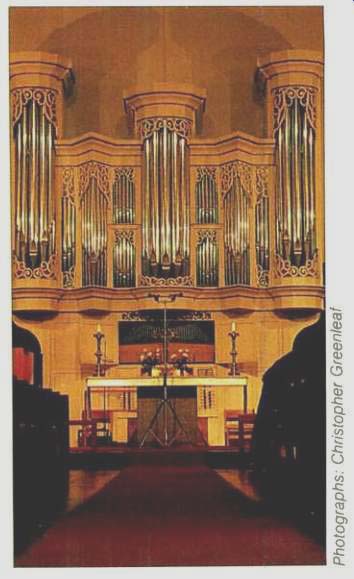
above: Hiroshi Tsuji's organ, in St. Paul's Church in Tokyo, was
built in the European tradition.
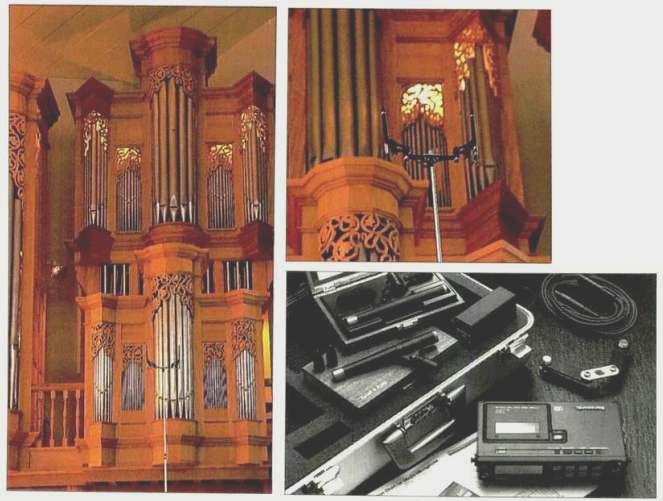
above: Another Tsuji organ, this one in Seinan Gakuin, Fukuoka, Japan;
note placement of mikes in the close-up. Lower photo is the Brüel & Kjaer
portable digital recording system with its Panasonic DAT recorder.
"But don't you have to space them very far apart, say, 2 meters or so, to get real stereo?" Popular myth certainly asserts that, uh, fact. The truth is that very fine omnis, as these B & K 4006s are, can achieve credible stereo with spacings as close as 10 cm (that's 4 inches, to the non-metrically inclined). On average, my spacing was 25 to 35 cm, at heights from 2 to 4.5 meters above the floor, depending an organ location, and up to 3 meters away from the closest part of the instrument.
The B & K mike body cannot be separated from the diaphragm, so there is no conventional mike capsule.
One alters the sound characteristics by using differently configured grids or screens. I used the bright metal grid (flat on axis, very small high-treble roll-off off-axis) for relatively close pickup in one rather dead room. But, where I wanted a certain distance from the instrument yet aimed to preserve the presence of each individual pipe's speech, the black grid (excellent high treble "reach" on axis, essentially flat off axis) was more accurate and musical. In rooms offering lots of usable reverberation, I planted the black nose cones (very close to a perfect omni pattern all around) relatively close to the organ facade but still far enough away for true 16-foot bass to develop.
And where the room acoustics were just not pretty enough to complement the organ sound, the mysterious little spheres proved their worth.
What do these odd-looking addenda to the accessory list do? They are, in effect, mechanical frequency filters.
They slip over the mike body and sit flush with the front surface of the transducer diaphragm. At bass frequencies and in the lower midrange, the mikes act like normal omnis; above 1 kHz, though, these 5-cm turned balls of non-resonant, highly reflective plastic attenuate off-axis sound by up to 5 dB at 90° and up to 14 dB at the back of the mike body.
The electronic chain, as well as the critical area immediately surrounding the diaphragm, stays simple and unaltered, giving omni "sweetness" while it performs as a cardioid or sub-cardioid.
I used the two 4006s in a variation of one traditional cardioid array: 100° at 35-cm separation, as opposed to the "orthodox" 1100/17-cm ORTF configuration. The recorded sound is warm, full, totally lacking in cardioid coloration, and possessed of both good center-fill and astonishing mono compatibility! In summing up the 10 frenetic days of travelling, recording, consuming Teals in hotels and scattered Japanese eateries, and listening to takes on the bullet train, I must say that the convenience and sound quality of the B & K/Panasonic package were exemplary. But the real heroes of this trip were the musical, bulletproof, sweet-sounding omnidirectional microphones. Who, just a few years ago, would have thought it possible to make a recording good enough for a Compact Disc out of gear that could be carried in one small travel case? And that you would be relying solely on a single pair of omnis in the bargain!
To the Galapagos Islands
By John M. Woram
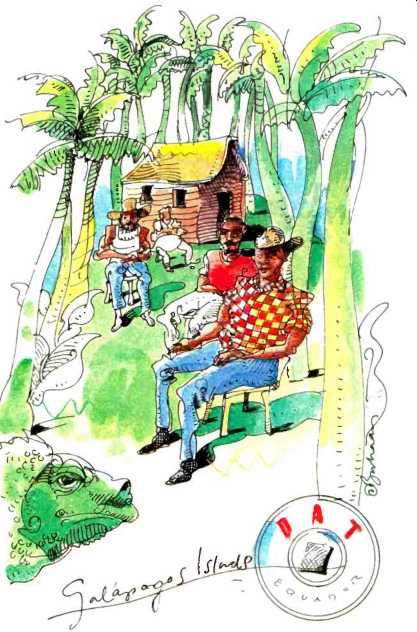
In 1854, Herman Melville wrote of the Encantadas, those distant and desolate "enchanted" islands that were "like split Syrian gourds left withering in the sun, are cracked by an everlasting drought beneath a torrid sky. In no world but a fallen one could such lands exist." Melville had just returned from a visit to the Galápagos Islands, which lie several hundred miles off the Pacific coast of Ecuador. Cut by the equator, the islands had not yet been discovered by the tourist trade. Even today they are--for very good reason--mostly uninhabited, save for giant tortoises, ugly iguanas, and, of course, Darwin's famous finches.
During the years before World War II, a handful of European settlers came out in search of a better life. Most of them didn't find it. They either died, or left quickly. Yet a hardy few did manage to hang on in this land where Mother Nature does not look kindly on humans. After the war, the pioneers were joined by others who came to scratch subsistence from the inhospitable soil. Still later, others arrived in search of making a fortune from tourism. Today, for better or worse, the Galápagos are no longer terra incognita. Much to the horror of the earliest settlers, the enchanted isles are well on their way to becoming, as the glossy brochures put it, a tourist "destination." This remote land, where the paved street is still a bit of a novelty, where the telephone has just begun to show up, and where electricity is a sometime thing, might not seem a likely venue for a digital recording session. There are no beautifully voiced pipe organs here, no string quartets, possibly not even an in-tune piano. Yet there I was, armed with a Sony TCD-D3 DAT Walkman and an assortment of support equipment, ready for " Enchanted Islands, Take 1." To make a long, and no doubt dreadfully boring, story short, I was back again in my favorite hide-out from the world of high-tech. The purpose of this visit-my ninth-was to assist colleague Jerry Emory in recording the oral histories of these islands' early settlers. They're all getting on in years and won't be with us much longer, so we hoped to preserve their stories on tape while there were still some stories to be preserved.

above: A Galapagos Island native, the iguana
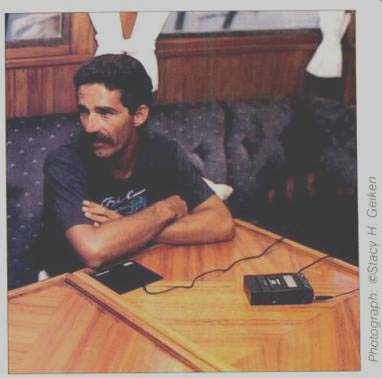
above: Felipe Cruz, who spends much time evaluating the impact
of tourism on the island, served as guide for this trip.
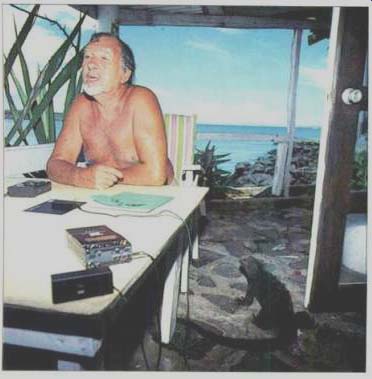
above: Carl Angermeyer came to the Islands in 1937 and waxes nostalgic
of his early days in abandoned pirate caves.
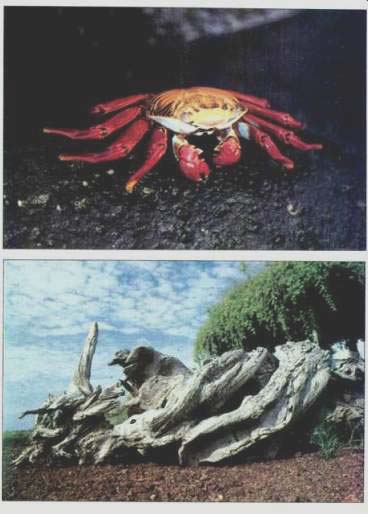
above: Sally Lightfoot (top) and driftwood
Unlike Chris Greenleaf's Japanese trip, this was to be low-tech all the way.
Given the work at hand, phone-line fidelity was about all we required. Stereo? Not necessary. In fact, even my best microphone-the superb Neumann KM140 that any interviewer might kill for-was of little use. I found out why the hard way, after one reluctant subject was finally persuaded to chat with us mañana. When the great day arrived, he almost froze to death of mike fright-quite an accomplishment on the equator. So I made a great show of unplugging the KM while Jerry dusted off his best Spanish to speak of days gone by. I casually placed a Radio Shack PZM on the floor next to my open camera bag, then tossed the Sony into the bag (carefully, of course, so as not to defeat the record mode). Our subject watched the proceedings with mild curiosity, then started to tell Jerry all about the old days. And I busied myself cleaning some camera lenses. After a pleasant morning of anecdotes and a tall tale or two, we bid our friend a pleasant adios and beat it back to the boat where we kept the battery charger.
Given our low-fi requirements, going digital might seem a bit of overkill, perhaps even silly. For even under the best of conditions, the Galápagos environment is not hospitable to the accoutrements of civilization. And this year was not the best of conditions.
Every 10 years or so, the west coast of South America and the islands are tormented by El Niño, a complete disruption of the normal weather pattern. Like children everywhere, some Niños are worse than others: The last biggie, in 1983, was described as possibly the worst natural disaster in recorded history. Nothing like that this year, but the islands were experiencing heavy rain, which in other years is so infrequent as to be considered a special event. Actually, there were only about two days in as many weeks in which the rains came, but on other days it might just as well have been pouring, so high was the humidity. At 9 a.m. the temperature was over 110°, and it got up to 122° on one sunny day.
All this takes its toll on humans and hardware. Camera straps and leather belts disintegrate before one's eyes. Clothes get wet and stay wet. Books come unglued (to say nothing of their readers), and fungus begins growing in the most inconvenient places. Now, then, is this a fit environment for a digital tape recorder? Well, yes. After taking some minimal precautions, the damned thing worked without incident through it all. Even the batteries lasted about as long as they were expected to last when used under normal conditions by normal people (both in short supply down there). The first thing to do is get rid of all shiny black plastic cases. Protect your toys in a neutral-color canvas bag or you'll have barbecued electronics before you can say "Golly, it's hot here." And try to keep that PZM mike (again, black) in the shade. Unfortunately, manufacturers of cameras and recorders--digital or otherwise--seem to have studied at the Henry Ford Fashion School, where the motto is: "Any color you like, provided you like black." It all looks very elegant up in el Norte, but it can mean instant death on the equator.
As another precaution, tape down the various slide switches so you don't wind up in the wrong mode. Every now and then I'd find the DAT in its LP (four-hour) mode but soon found this was no big deal. I could flip back to normal mode during recording at a cost of about one syllable of voice as the machine switched modes. Other than that, the transition was inaudible (not recommended for serious music recording, though). Perhaps the strongest argument for the DAT recorder was its running time.
Given the problems of interview technique that are so often a function of this kind of work, the ability to record two uninterrupted hours is a luxury not to be underestimated. On at least a few occasions, our subject would be distracted when our backup analog recorder ran out of tape. The simple act of flipping the cassette would bring conversation to a screeching halt and it would take at least a little while to get back up to (conversational) speed.
Looking back, perhaps I should have recorded everything in the LP mode, since the slight loss in fidelity meant nothing under the circumstances. However, the two hours available in normal mode more or less matches the useful battery life So when the tape runs out, it's time to change the battery. If the battery light comes on, change the tape when you swap batteries. Not elegant but it works.
What about next time? Well, a four hour battery would be nice, as would some means of recharging the recorder batteries from a 12-V d.c. source Galápagos is not the only place in this world where a.c. cannot be taken for granted. But there's usually a storage battery in someone's boat that can be pressed into service.
Oh, and a sturdy gray case would be nice too.
(Source: Audio magazine, Sept. 1991)
Also see:
DECIDING ON DAT: Witness of the Persecution (Mar. 1988)
Digital Doctor: A look at DAT and MiniDisc (May 1997)
Audio in China: Hi-Fi Takes a Great Leap Forward (Apr. 1989)
= = = =